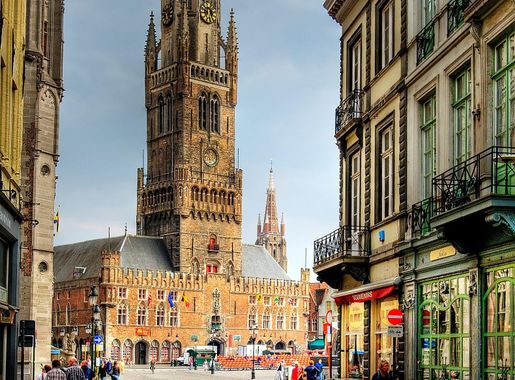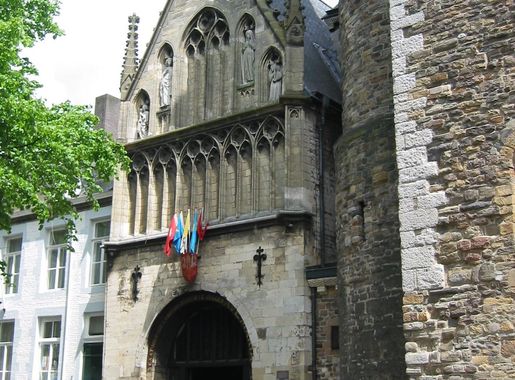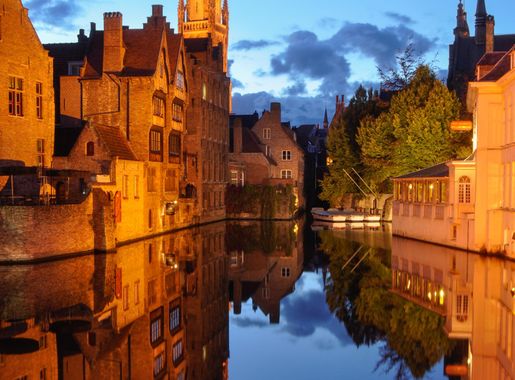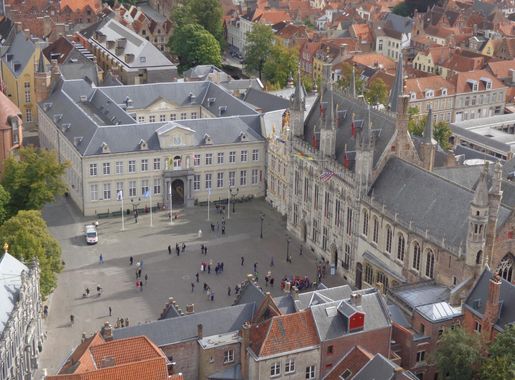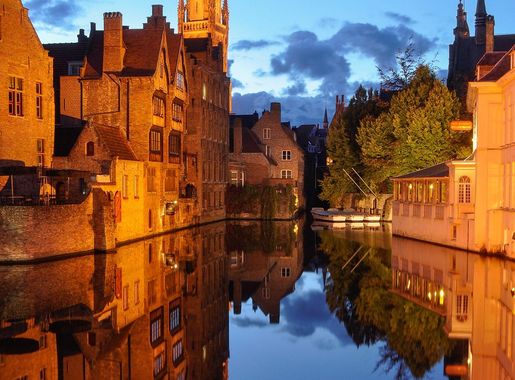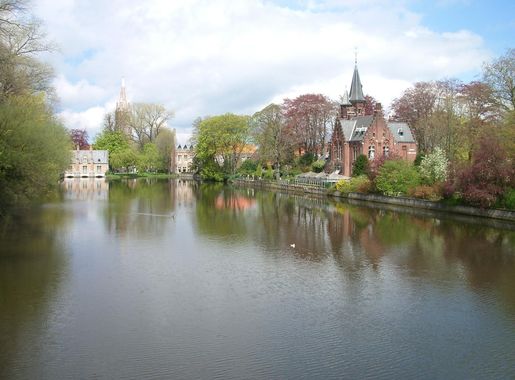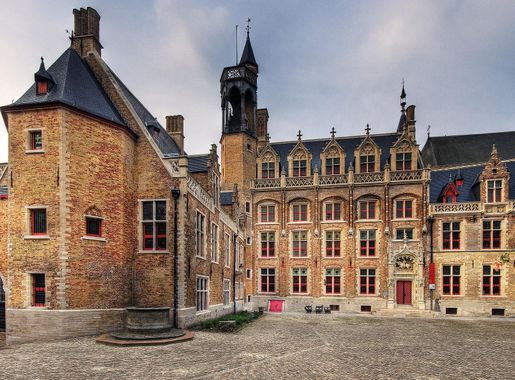
Enchanting Cobblestones: The Historic Centre of Bruges
Discover the Historic Centre of Bruges: A UNESCO World Heritage site with medieval architecture, picturesque canals, and rich cultural history in the heart of Belgium.
The Historic Centre of Bruges is a fairy-tale setting that transports you back in time. As you walk along its cobblestone streets, you will be surrounded by stunning medieval architecture and picturesque canals. This UNESCO World Heritage site is often referred to as the 'Venice of the North' due to its extensive network of canals that crisscross the city. The Belfry of Bruges, a medieval bell tower, offers panoramic views of the city and is a must-visit landmark. At the heart of the Historic Centre is the Markt, a lively square where you can find charming cafes, horse-drawn carriages, and the iconic Provincial Court building. Nearby, the Burg Square boasts the Basilica of the Holy Blood, renowned for housing a relic believed to contain the blood of Jesus Christ. The square is also home to the Gothic-style Town Hall, a testament to Bruges' rich history. Don't miss the chance to explore the serene Minnewater Park, often referred to as the 'Lake of Love,' where you can enjoy a peaceful walk or a relaxing boat ride. For art enthusiasts, the Groeningemuseum offers an impressive collection of Flemish and Belgian masterpieces. The Historic Centre of Bruges is not just a visual delight; it is a cultural and historical treasure trove that promises an unforgettable experience.
Local tips in Historic Centre of Bruges
- Wear comfortable shoes; the cobblestone streets can be uneven.
- Visit early in the morning or late in the afternoon to avoid the crowds.
- Try the local chocolate shops for an authentic Belgian treat.
- Consider a canal boat tour for a unique perspective of the city.
- Check the schedule for the Belfry's carillon concerts.
Enchanting Cobblestones: The Historic Centre of Bruges
The Historic Centre of Bruges is a fairy-tale setting that transports you back in time. As you walk along its cobblestone streets, you will be surrounded by stunning medieval architecture and picturesque canals. This UNESCO World Heritage site is often referred to as the 'Venice of the North' due to its extensive network of canals that crisscross the city. The Belfry of Bruges, a medieval bell tower, offers panoramic views of the city and is a must-visit landmark. At the heart of the Historic Centre is the Markt, a lively square where you can find charming cafes, horse-drawn carriages, and the iconic Provincial Court building. Nearby, the Burg Square boasts the Basilica of the Holy Blood, renowned for housing a relic believed to contain the blood of Jesus Christ. The square is also home to the Gothic-style Town Hall, a testament to Bruges' rich history. Don't miss the chance to explore the serene Minnewater Park, often referred to as the 'Lake of Love,' where you can enjoy a peaceful walk or a relaxing boat ride. For art enthusiasts, the Groeningemuseum offers an impressive collection of Flemish and Belgian masterpieces. The Historic Centre of Bruges is not just a visual delight; it is a cultural and historical treasure trove that promises an unforgettable experience.
Iconic landmarks you can’t miss
Belfry of Bruges
Discover the iconic Belfry of Bruges, a UNESCO World Heritage site that offers breathtaking views and a rich tapestry of history in the heart of Belgium.
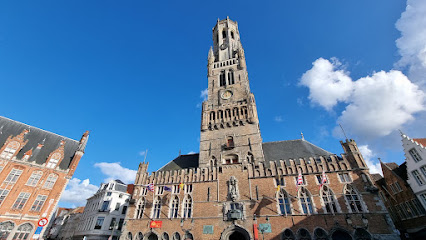
Historium Bruges
Explore the heart of medieval Bruges at Historium, where immersive experiences and stunning views reveal the city's rich history.
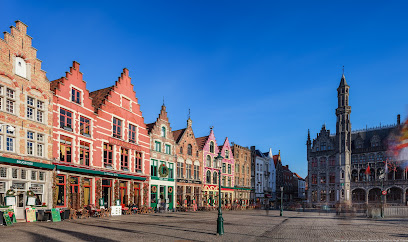
De Burg
Explore the historic De Burg in Bruges, a captivating square rich in architectural beauty and cultural heritage, perfect for a leisurely visit.
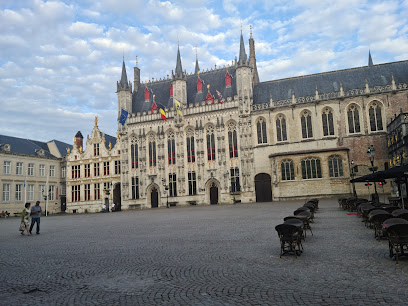
Kruispoort gate
Discover Bruges' Kruispoort Gate, a historical gem that reflects the city's medieval heritage and offers stunning views along the tranquil canals.
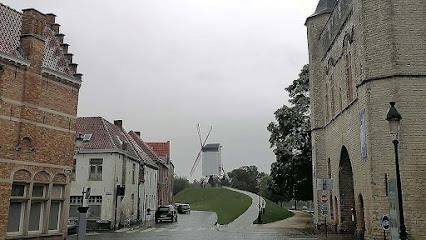
Statue of Saint Joannes Nepomucenus
Explore the Statue of Saint Joannes Nepomucenus in Bruges, a historic landmark that reflects the city's rich heritage and artistic craftsmanship.
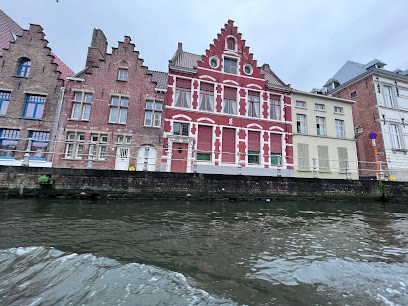
Pieter de Coninck en Jan Breydel
Explore the iconic Pieter de Coninck en Jan Breydel monument in Bruges, a landmark celebrating the city's rich historical legacy and vibrant culture.
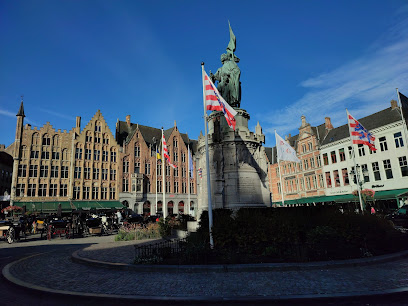
Viewpoint De Dijver
Discover breathtaking views and rich history at Bruges' iconic Viewpoint De Dijver, where medieval charm meets serene canal beauty.

De Dijver park
Explore the tranquil beauty of De Dijver Park in Bruges, where history, nature, and picturesque views come together for an unforgettable experience.
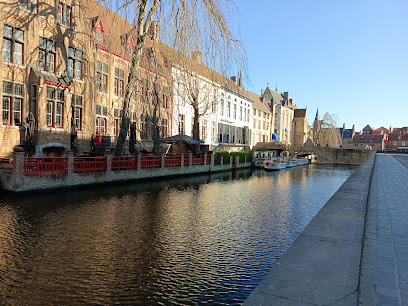
Gotische Zaal
Explore the Gothic Hall in Bruges, a stunning museum showcasing the city's historical treasures and architectural beauty.
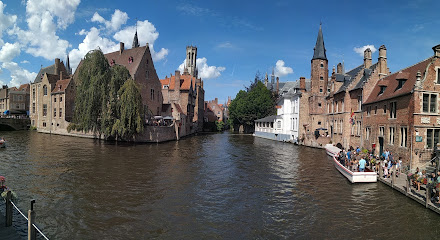
Genthof 7
Discover Genthof 7 in Bruges: a captivating historical landmark showcasing exquisite medieval architecture and rich cultural heritage.
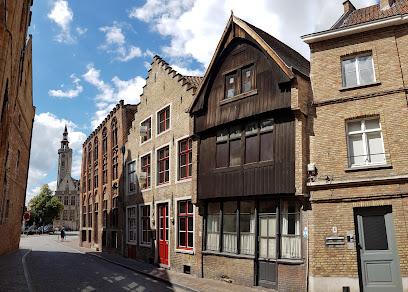
Medieval Wooden Facade (15th Century)
Discover the Medieval Wooden Facade in Bruges, a stunning 15th-century architectural marvel that showcases the city's rich historical heritage.
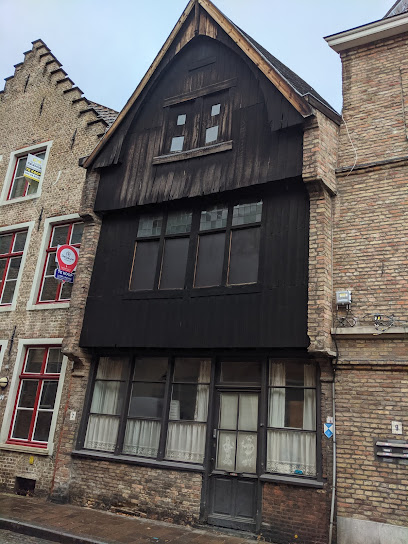
Oude Kazernepoort
Discover the historical significance and architectural beauty of Oude Kazernepoort in Bruges, Belgium, where history and culture converge.
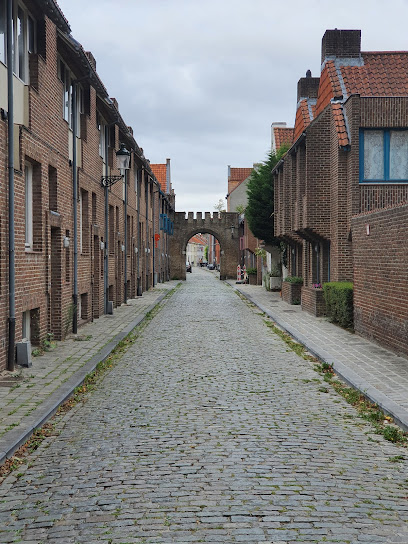
Mariabeeld
Explore the Mariabeeld in Bruges, a historical landmark that embodies the city's rich heritage and artistic traditions amidst beautiful architecture.
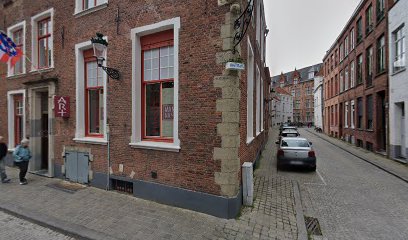
Unmissable attractions to see
Torture Museum Oude Steen Brugge
Explore the chilling history of punishment and justice at the Torture Museum in Bruges, Belgium - a captivating glimpse into medieval practices.

Wijngaardplein
Explore Wijngaardplein, a charming square in Bruges, rich in history, culture, and picturesque views perfect for every traveler.
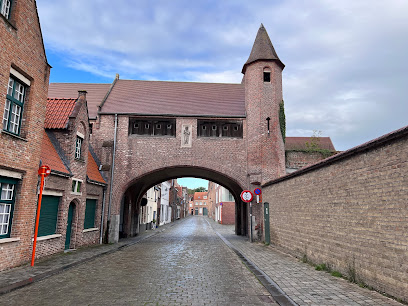
Oude Kazernepoort
Discover the historical beauty of Oude Kazernepoort, a gateway to Bruges' enchanting medieval charm and picturesque canals.
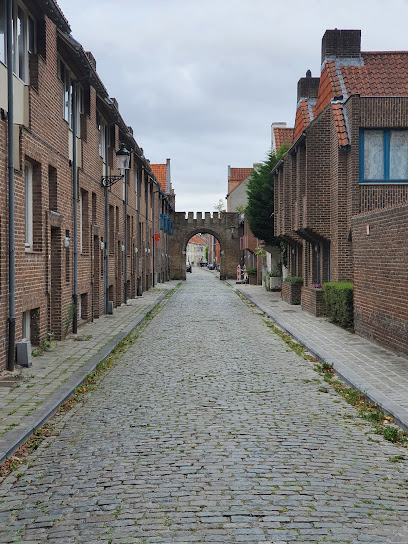
Essential places to dine
Cambrinus
Experience the best of Belgian cuisine and an unparalleled beer selection at Cambrinus, a must-visit brasserie in Bruges.
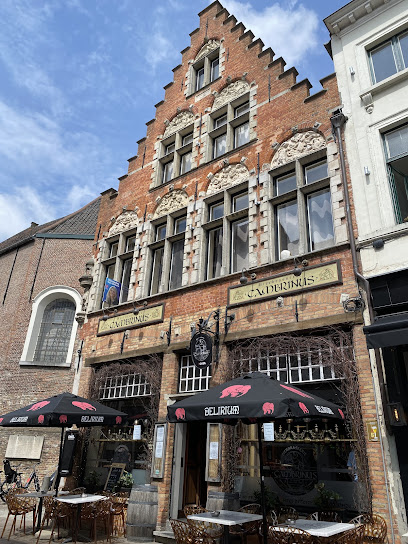
That's Toast
Discover Bruges' finest brunch spot at That's Toast - where every bite is a taste of culinary creativity.
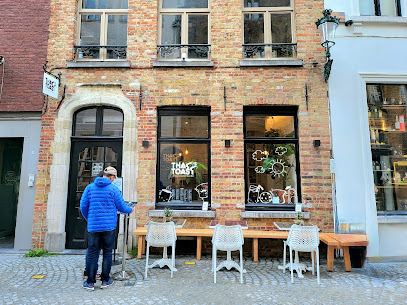
Poules Moules
Experience authentic Belgian cuisine at Poules Moules in Bruges - home of exquisite moules-frites and delightful seafood dishes.
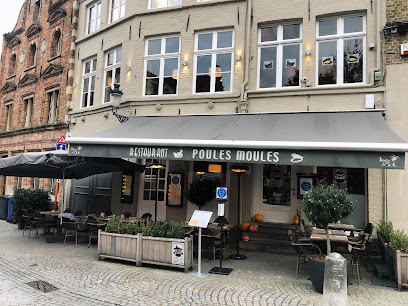
De Gastro
Discover authentic Belgian flavors at De Gastro in Bruges – where tradition meets taste in every dish.
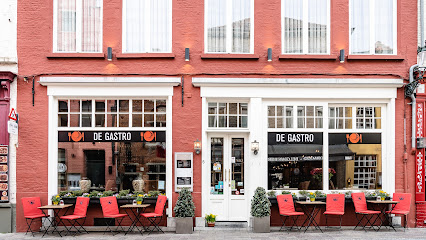
Mozart, More Than Just Ribs
Savor the best ribs in Bruges at Mozart - where flavor meets exceptional hospitality.
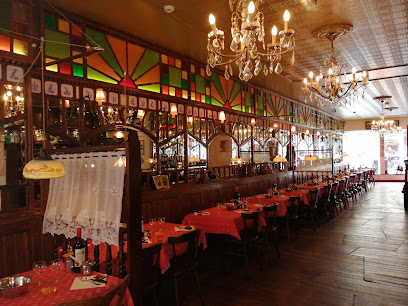
The Olive Tree Brugge
Experience authentic Greek flavors at The Olive Tree Brugge, where Mediterranean cuisine meets Belgian charm in a cozy setting.
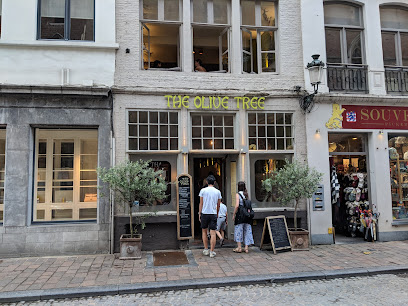
Restaurant Diligence
Savor authentic Belgian cuisine at Restaurant Diligence, where every dish tells a story in the heart of Bruges.
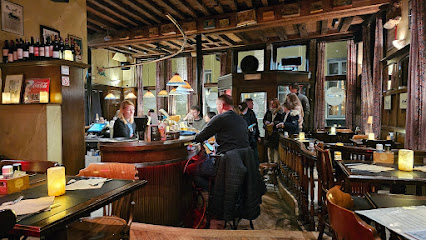
Belgian Pigeon House
Experience authentic Belgian cuisine at the Belgian Pigeon House in Bruges - where tradition meets taste in every delightful dish.
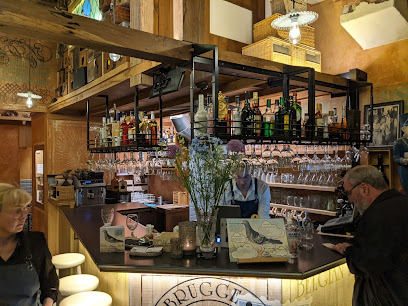
Restaurant Chagall
Discover Restaurant Chagall: A unique dining experience in Bruges blending art and exquisite Belgian cuisine amidst cinematic charm.
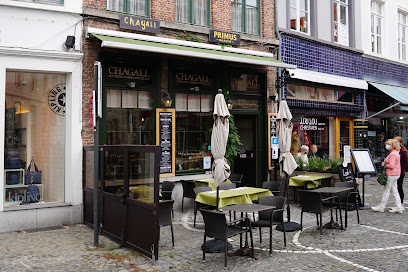
BOEM PATAT
Savor authentic Belgian fries in the heart of Bruges at Boem Patat - where tradition meets taste.
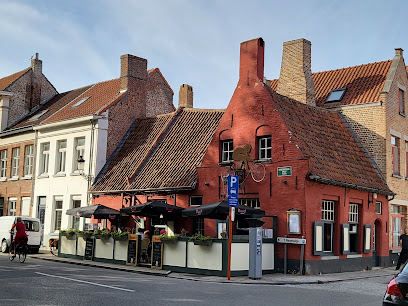
Markets, malls and hidden boutiques
Olleke, Wizarding Shop Brugge
Discover the magic at Olleke, Bruges' enchanting wizarding shop offering unique gifts, collectibles, and toys for all ages.
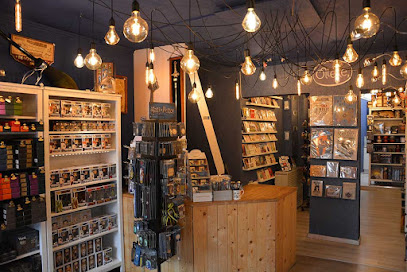
Het Brugs Theehuis
Experience the serene atmosphere and exquisite selection of teas at Het Brugs Theehuis, a hidden gem in the heart of Bruges, Belgium.
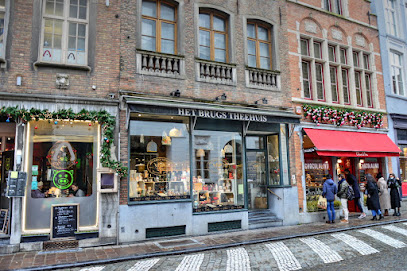
Käthe Wohlfahrt
Discover the enchanting Käthe Wohlfahrt in Bruges, where Christmas magic meets traditional Belgian charm in a delightful souvenir store.
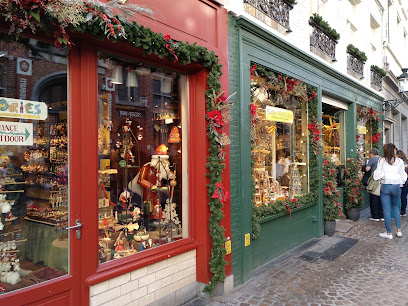
CASA Brugge Geldmuntstraat
Explore CASA Brugge Geldmuntstraat for unique gifts, stylish home essentials, and a delightful shopping experience in the heart of Bruges.
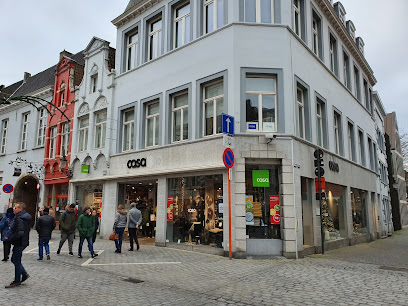
Toucan
Explore the unique offerings of Toucan Gift Shop in Bruges, where local artistry meets memorable souvenirs and gifts.
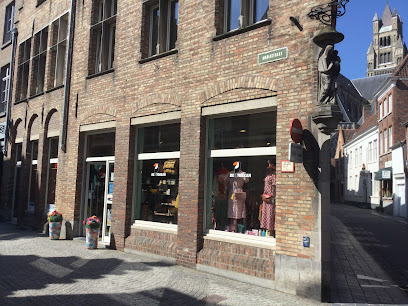
'T Apostelientje
Discover a treasure trove of vintage artifacts and antiques at 'T Apostelientje in Bruges, a must-visit for history enthusiasts and collectors alike.
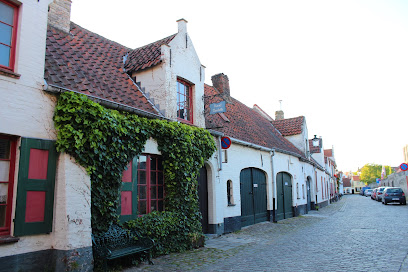
Pickeryshop
Discover authentic Bruges souvenirs at Pickeryshop, where local crafts meet unique keepsakes in a charming setting.
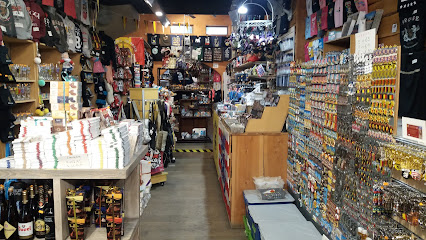
The Old Curiosity Shop
Explore The Old Curiosity Shop in Bruges, a unique map and collectibles store offering treasures that capture the city's rich heritage.
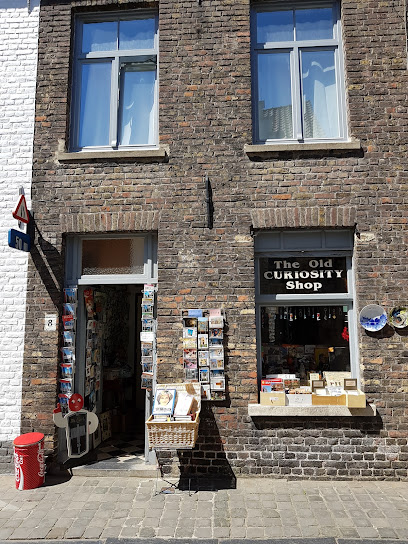
BCN Winkel
Explore the charm of Bruges at BCN Winkel, your go-to souvenir store for unique local treasures and heartfelt mementos.
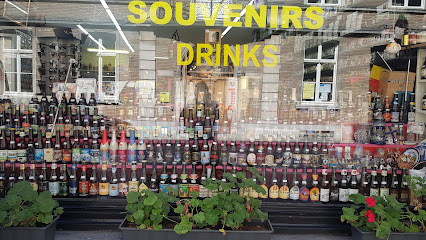
Souvenirshop Brugge
Explore authentic Belgian souvenirs at Souvenirshop Brugge, where local craftsmanship meets charming hospitality.
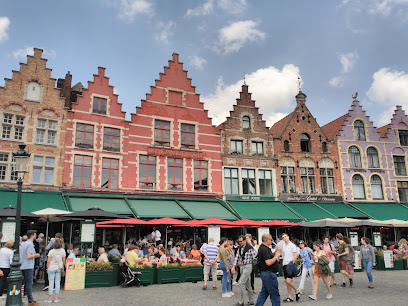
Essential bars & hidden hideouts
De Garre
Discover the charm of De Garre, a hidden bar in Bruges known for its cozy atmosphere and remarkable selection of local beers.

Le Trappiste
Experience the essence of Belgian beer culture at Le Trappiste, a cozy bar and café in the heart of Bruges.
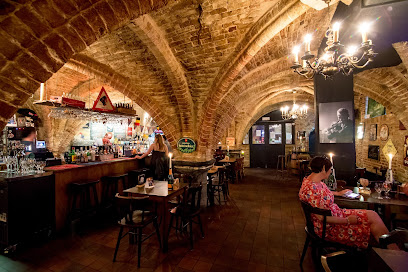
Bar Des Amis
Discover the charm of Bar Des Amis in Bruges, where delightful drinks meet a cozy atmosphere for an unforgettable experience.
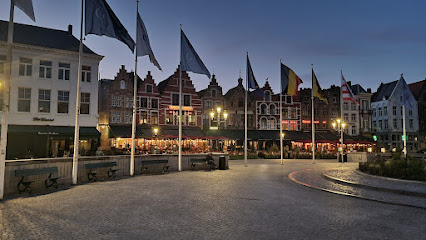
Groot Vlaenderen
Discover Groot Vlaenderen, Bruges' upscale cocktail bar, where exquisite drinks meet a vibrant atmosphere, perfect for a night out.
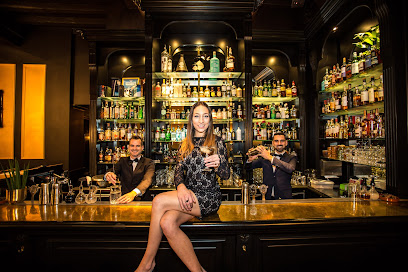
Bieratelier Brugge
Experience the best of Bruges at Bieratelier Brugge, where local beers and delicious cuisine meet in a cozy atmosphere.
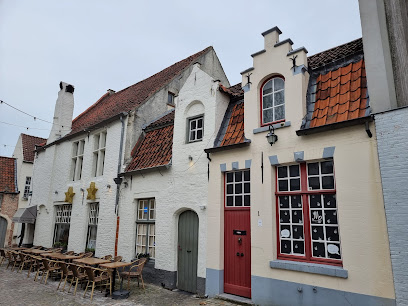
BAR 'N
Discover the eclectic charm of BAR 'N, a unique bar in Bruges offering a vibrant atmosphere and a wide range of beverages.
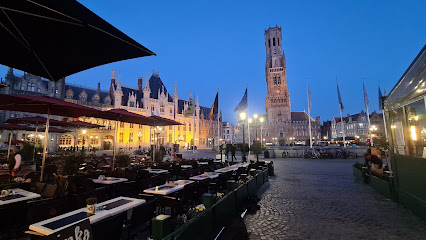
Beers Yesterday's World - Brugge
Experience the vintage allure of Beers Yesterday's World, a unique bar in Bruges offering local beers and a cozy ambiance filled with antiques.
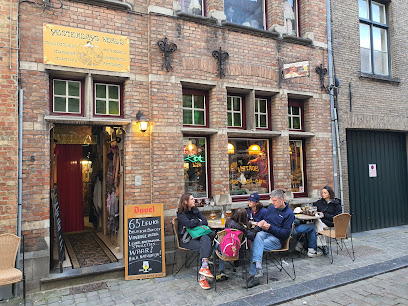
The Vintage
Discover the vintage charm and vibrant atmosphere of The Vintage Bar in Bruges, a perfect spot for drinks and relaxation after a day of exploration.
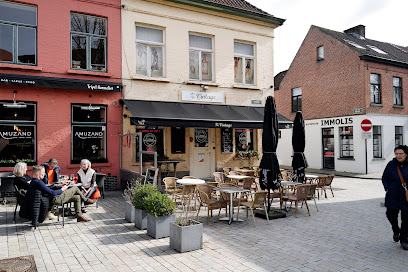
Duvelorium Belgian Beer Bar
Discover the best of Belgian beer culture at Duvelorium Belgian Beer Bar, located in the vibrant Markt square of Bruges.
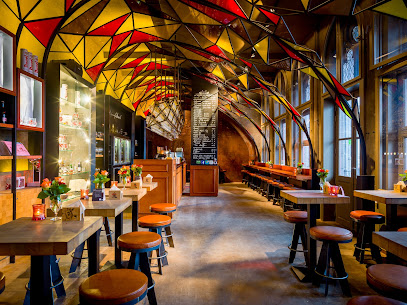
Bar Ran
Discover the vibrant cocktail culture at Bar Ran, Bruges' premier cocktail bar offering exquisite drinks in a charming ambiance.
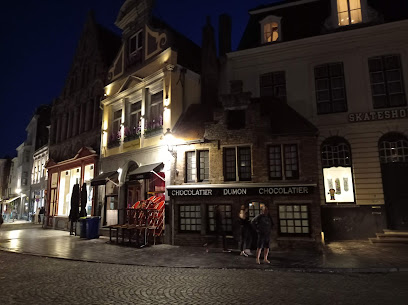
Local Phrases
-
- HelloHallo
[ha-lo] - GoodbyeTot ziens
[tot zeens] - YesJa
[ya] - NoNee
[nee] - Please/You're welcomeAlstublieft
[al-stu-bleeft] - Thank youDank u
[dank oo] - Excuse me/SorrySorry
[so-ree] - How are you?Hoe gaat het met u?
[hoo gat het met oo] - Fine. And you?Goed. En met u?
[hood. en met oo] - Do you speak English?Spreekt u Engels?
[spraykt oo engels] - I don't understandIk begrijp het niet
[ik buh-greip het neet]
- HelloHallo
-
- I'd like to see the menu, pleaseMag ik de menukaart zien, alstublieft
[mag ik de menu-kart zeen, al-stu-bleeft] - I don't eat meatIk eet geen vlees
[ik eet kheen vlays] - Cheers!Proost!
[prohst] - I would like to pay, pleaseIk wil graag betalen, alstublieft
[ik vil khraahg buh-ta-len, al-stu-bleeft]
- I'd like to see the menu, pleaseMag ik de menukaart zien, alstublieft
-
- Help!Help!
[help] - Go away!Ga weg!
[ga vekh] - Call the Police!Bel de politie!
[bel de po-lee-see] - Call a doctor!Bel een dokter!
[bel ayn dohk-ter] - I'm lostIk ben verdwaald
[ik ben fer-dwahld] - I'm illIk ben ziek
[ik ben zeek]
- Help!Help!
-
- I'd like to buy...Ik zou graag ... kopen
[ik zou khraahg ... koh-pen] - I'm just lookingIk kijk alleen maar
[ik kayk al-leen maar] - How much is it?Hoeveel kost het?
[hoo-veel kost het] - That's too expensiveDat is te duur
[dat is tuh dyoor] - Can you lower the price?Kunt u de prijs verlagen?
[kunt oo de preis ver-lah-ghen]
- I'd like to buy...Ik zou graag ... kopen
-
- What time is it?Hoe laat is het?
[hoo laat is het] - It's one o'clockHet is een uur
[het is ayn oor] - Half past (10)Half elf
[half elf] - MorningOchtend
[okhtend] - AfternoonMiddag
[mid-dahkh] - EveningAvond
[ah-vond] - YesterdayGisteren
[khis-teh-ren] - TodayVandaag
[vahn-dahkh] - TomorrowMorgen
[mor-khen] - 1Een
[ayn] - 2Twee
[tveh] - 3Drie
[dree] - 4Vier
[veer] - 5Vijf
[vayf] - 6Zes
[zehs] - 7Zeven
[zeh-ven] - 8Acht
[ahkht] - 9Negen
[nay-khen] - 10Tien
[teen]
- What time is it?Hoe laat is het?
-
- Where's a/the...?Waar is de ...?
[var is de] - What's the address?Wat is het adres?
[vat is het ah-dres] - Can you show me (on the map)?Kunt u mij laten zien (op de kaart)?
[kunt oo may la-ten zeen (op de kaart)] - When's the next (bus)?Wanneer is de volgende (bus)?
[ven-nar is de vol-hen-de (bus)] - A ticket (to ....)Een kaartje (naar ....)
[ayn kart-ye (nar)]
- Where's a/the...?Waar is de ...?
History of Historic Centre of Bruges
-
The Historic Centre of Bruges, known as the 'Venice of the North', began its ascent as a major trade hub in the 9th century. Its strategic location along the Zwin River facilitated trade with England and the Scandinavian countries, leading to its growth as a commercial center. Bruges became pivotal in the cloth trade, drawing merchants from across Europe and establishing itself as a key player in the medieval economy.
-
During the 12th to 15th centuries, Bruges experienced its Golden Age, characterized by immense wealth generated from trade, particularly in textiles. The construction of the iconic Belfry of Bruges in 1240 and the expansion of the Markt square reflect the city's prosperity. This period saw the rise of wealthy merchant families and the establishment of influential guilds, which shaped the city’s political and economic landscape.
-
The late Middle Ages marked a cultural flourishing in Bruges, with the city becoming a center for the arts. The works of Flemish painters such as Jan van Eyck and Hans Memling, who created masterpieces while residing in the city, contributed to Bruges' reputation as a cradle of Renaissance art. The presence of the Church of Our Lady, housing Michelangelo's Madonna and Child, exemplifies the rich cultural heritage of the Historic Centre.
-
The decline of Bruges began in the 16th century due to the silting of the Zwin River and the rise of Antwerp as a commercial port. This shift led to economic hardship, and many residents left the city. Despite this decline, Bruges preserved its medieval architecture, which would later contribute to its recognition as a UNESCO World Heritage site in 2000, attracting tourists and fostering a revival of interest in its rich history.
-
In the 19th and 20th centuries, Bruges underwent significant preservation efforts, with a focus on maintaining its historic character. The city embraced tourism, capitalizing on its medieval charm and cultural significance. Today, the Historic Centre of Bruges is a bustling area filled with cobblestone streets, historic buildings, and cultural landmarks, serving as a testament to its storied past while engaging with contemporary society.
Historic Centre of Bruges Essentials
-
The Historic Centre of Bruges is easily accessible from various neighborhoods in Bruges. If you're coming from the train station, it's a pleasant 15-20 minute walk to the heart of the city. Alternatively, you can take bus lines 1, 6, or 12, which connect the station to the city center. If you're in other neighborhoods, cycling is a popular option, as Bruges is very bike-friendly.
-
The Historic Centre of Bruges is compact and best explored on foot. Many attractions are within walking distance. For longer distances, bicycles can be rented at various locations throughout the city. Public transport options include buses that connect to outer districts, but they are less frequently used within the city center. Taxis are available but may not be necessary given the walkability of the area.
-
Bruges is generally a safe destination for tourists. However, petty crime, such as pickpocketing, can occur in crowded areas, particularly around popular attractions like the Markt and the Belfry. It's advisable to keep your belongings secure and be cautious in busy spots. Avoid isolated areas at night.
-
In case of an emergency, dial 112 for police, ambulance, or fire services in Belgium. For non-urgent police matters, you can visit the local police station located in the city center. Medical assistance is available at various clinics and hospitals in Bruges. It’s recommended to have travel insurance that covers emergencies.
-
Fashion: Do wear comfortable shoes for walking, as the cobblestone streets can be uneven. Don’t wear overly casual attire if dining in upscale restaurants. Religion: Do respect local customs, especially in churches; avoid loud conversations. Public Transport: Do follow local etiquette and be courteous to fellow passengers. Don’t eat or drink on buses. Greetings: Do greet with a friendly 'Hallo' or 'Bonjour' and a smile. Eating & Drinking: Do try local specialties like Flemish stew and chocolate. Don’t waste food, as it’s considered disrespectful.
-
To experience the Historic Centre of Bruges like a local, explore the lesser-known alleys and canals away from the main tourist routes. Visit the local markets, especially on Wednesdays, for fresh produce and crafts. Engage with local artisans in workshops or small shops, and consider joining a guided walking tour to learn about the city's rich history. Don’t miss the opportunity to try local beers at smaller, less touristy pubs for an authentic taste of Bruges.
Trending Landmarks in Historic Centre of Bruges
Nearby Cities to Historic Centre of Bruges
-
Things To Do in Zeebrugge
-
Things To Do in Blankenberge
-
Things To Do in De Haan
-
Things To Do in Knokke-Heist
-
Things To Do in Ostend
-
Things To Do in Ostend-Bruges International Airport
-
Things To Do in Nieuwpoort
-
Things To Do in Ghent
-
Things To Do in Kortrijk
-
Things To Do in Ypres
-
Things To Do in Aalst
-
Things To Do in Lille
-
Things To Do in Tournai
-
Things To Do in Antwerp
-
Things To Do in Brussels

